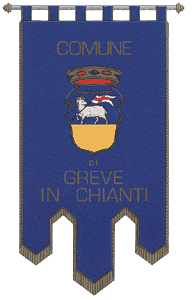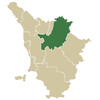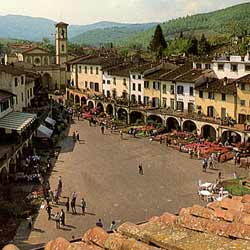|
 Inhabitants in 1991: 11.139 Inhabitants in 1991: 11.139
 The
municipal territory of Greve extends for 169.04 square kilometres mostly
in the middle and high hills of the valley of the same name between the
Val d'Ema, Val de Pesa and the Chianti mountains. Seat of Office of
a Podesta it became community in 1773 and to it was also aggregated
that part of the territory formerly belonging to the League of Cintoia. The
municipal territory of Greve extends for 169.04 square kilometres mostly
in the middle and high hills of the valley of the same name between the
Val d'Ema, Val de Pesa and the Chianti mountains. Seat of Office of
a Podesta it became community in 1773 and to it was also aggregated
that part of the territory formerly belonging to the League of Cintoia.
Greve during the Dark Ages developed itself as "market"
of Monteficalle and the other neighbouring castles. Small agglomerate
- until the middle of the 1400 it was not yet a Parochial Seat and in
the census of 1551 the village counted only 92 inhabitants
- it saw a rapid growth from the second half of the XVI century,
certainly favoured by its geographical position, finding itself at the
crossroad of the road which ran from Firenze to Chianti and that
which ran from Valdipesa to Figline, and in consequence of its busy weekly
market it developed the characteristic square which even today
is still the heart of the town.
 Then
becoming capital of the League of Val di Greve and Podesta Seat of Office,
in modern times it was already a centre of discreet importance ("the
place is big and clean", wrote Pietro Leopoldo in 1773) and
proceeded then in its growth to arrive at doubling its own inhabitants
in the course of the 1800s. Many of the castles in its territory
are rich in history , ancient possessions of eminent families of Firenze;
other than the already mentioned Monteficalle (today Montefioralle) one
notes also Panzano, the first documentation of which is in 1041
and was for a long time the most populated centre in the Val de Greve;
Lamole and Uzzano , two of the tiniest castles of the area; Cintoia,
today a deserted village, but an important settlement probably from the
Longobarda era. Among the illustrious sons of the municipality
was the politician Niccolo da Uzzano (1359 -1431) and the navigator
Giovanni da Verrazzano (1485 -1528). Then
becoming capital of the League of Val di Greve and Podesta Seat of Office,
in modern times it was already a centre of discreet importance ("the
place is big and clean", wrote Pietro Leopoldo in 1773) and
proceeded then in its growth to arrive at doubling its own inhabitants
in the course of the 1800s. Many of the castles in its territory
are rich in history , ancient possessions of eminent families of Firenze;
other than the already mentioned Monteficalle (today Montefioralle) one
notes also Panzano, the first documentation of which is in 1041
and was for a long time the most populated centre in the Val de Greve;
Lamole and Uzzano , two of the tiniest castles of the area; Cintoia,
today a deserted village, but an important settlement probably from the
Longobarda era. Among the illustrious sons of the municipality
was the politician Niccolo da Uzzano (1359 -1431) and the navigator
Giovanni da Verrazzano (1485 -1528).
Places to visit:
Piazza Giovanni da Verrazzano,
its stretched out form, typical of a market, it is surrounded by Porticos.
In some of the town's building can be seen the original 1200-1300
shapes. |
Historical info reproduced upon authorization of
Regione Toscana - Dipartimento della Presidenza E Affari Legislativi e
Giuridici
Picture by Sandro Santioli
Translated by Ann Mountford
|